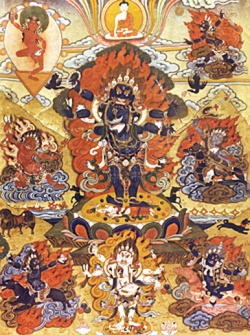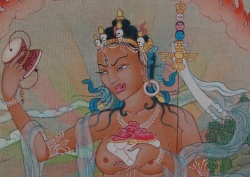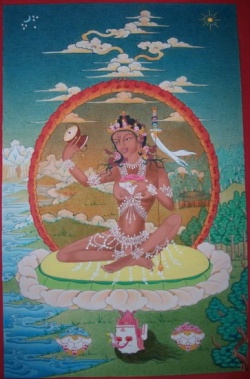The Five Cycles
The principal teachings transmitted by the Shangpa Kagyu consist of five cycles :
from Niguma: the Five Golden Dharmas (gser chos sde lnga);
from Sukhasiddhi: the Six Yogas and Mahamudra;
from Maitripa: the protector Mahakala Chadrupa, six-armed Mahakala; the practice of this deity spread to other schools from this Shangpa transmission;
from Abhaya (Droje Denpa ou Vajrasanapada): Five Tantric Deities that combines the main deities of the highest class of tantra (Anuttarayoga): Chakrasamvara, Guhyasamaja, Mahamaya, Hevajra, and Vajrabhairava.;
from Rahula: the Joint Practice of the Four Deities (lhashi drildrup).
These teachings constitute the heart of the transmission and practices for Shangpa three-year retreats.
The Five Golden Dharmas
Among the five cycles, the most famous one is Niguma’s Five Golden Dharmas.
The roots are the Six Yogas of Niguma which are very similar to the Six Yogas of Naropa as practiced by all other Kagyu schools.
The Six Teachings of Niguma include the teachings on inner heat(gtu mo, on illusory-body, on dream, on clear light, on transference (phowa), and on bardo (the intermediary state between death and birth).
The trunk is the Mahamudra of the Amulet Box (phyag chen ga’u ma).
The branches are the three ways of carrying-over (ordinary phenomena) onto the path (lam-khyer-gsum).
The flowers are the white and red forms of Khecari.
The fruit is (the realization of mind as) deathless and unerring.
These precepts were recorded on the basis of the adamantine verses (Vajrapada/ rdorje’i tshig-rkang) of the Jnanadakini Niguma.
Thus, even the meditation topics and the formula of supplication are not fabricated, altered, or corrupted by the thoughts of an ordinary individual, and, so, are like refined gold.
It appears that of the doctrines of the dakini of primordial awareness Sukhasiddhi only the most profound "Six Doctrines of the Path of Skillful Means" and the Mahamudra precepts of pure primordial awareness remain.
The "Sadhana which Subsumes Four Deities", a precept of the mahasiddha Rahula, and (the precepts of) the "Efficacious Lord of Primordial Awareness" (Mahakala), a profound doctrine of Maitri-pa, also still exist.
These appear really to possess a continuous transmission of spiritual experience and blessing.
The text below, translated by Matthew Kapstein, describes the Five Golden Dharmas:
a) The Six Doctrines of Niguma
The Vajrapadas say, with reference to the Six Doctrines:
Matured by the four empowerments, endowed with faith and strenuousness,
Practicing the preliminary meditations upon impermanence, disgust (with samsara), and hazards (of samsara),
Whoever strives at this supreme path,
Will attain Buddhahood within six months, a year, or
during this life.
Accordingly, an individual who is spiritually matured by receiving the empowerments of the five tantras which are taught in the "Ocean of Jewels of the Great Tantras", or of the mandala of Sri-Cakrasamvara,
and the transmitted blessing of each (of the Six Doctrines) and has well practiced the common preliminary meditations, first purifies himself by (the practice of) "the purifying empty enclosure (created by) the syllable A".
Then, (by the practice of) the "Path of Skillful Means" (upaya-marga/thabs-lam), the warmth of well-being blazes naturally.
By (the yoga of) the "Apparitional Body," attachment and aversion dissolve naturally.
By (the yoga of) the Dream, the subtle bewilderment (which underlies all bewilderment) is naturally cleansed.
By Limpid Clarity, ignorance is naturally dispelled.
Establishing these four as the root (of the practice), the defilements which arise in the bewilderment of the four states of being are removed.
The (remaining) two, Transference (of consciousness), by which Buddhahood is attained without having realized it in meditation (during this life), and the Intermediate State (antarabhava/bar-do),
by which the Sambhoga-kaya of the Buddha (is realized), are practiced as an appended meditational sequence for those who are lacking in strenuousness and acumen, whereupon, according to the grades of excellence, mediocrity,
or inferiority, one becomes liberated in (one or another of) the three Intermediate States.
b) The Mahamudra
The scholar-saint Khyungpo Naljor was exceedingly proud of the Vajrapadas which contain the precepts of the essential points which are incapable of intellectual formulation. Therefore, he inserted the paper rolls (on which they were written) into a small Nepalese amulet-box to wear around his neck.
Thus, the precepts became renowned as the "Amulet-box Precepts of the Mahamudra" (phyag-che ga’u-ma).
One first cultivates tranquility (samatha/zhi-gnas) and insight into the nature of reality (vipasyana/lhag-mthong) by the preliminary practice of the "natural disposition of body, speech and mind" (rang-babs-gsum).
Then, in the fundamental practice, the calling-down of the diamond-like primordial awareness causes one to steal a glimpse which introduces (the Mahamudra), whereupon, through the natural dissolution of the four faults (which would otherwise obstruct further progress),
all doubts in respect to the nature of mind-as-such are resolved.
In the final practice one sustains the Trikaya which has come about spontaneously, and, by relying on extraordinary means of boosting the practice and removing obstacles, the Mahamudra,
which is the heart of the doctrine of all sutras and tantras,
and the essence of all meditational precepts, becomes fully manifest as the natural liberation which is (the realization of) the four Kayas.
c) The Three Carry-Overs
By carrying over onto the path all phenomena of appearance, sound and thought, through the essential understanding that in actuality (they are) the Guru, the deity, and apparitional, in a matter of months or a year, (one realizes the unity of) clarity and emptiness as supreme bliss and the Trikaya is naturally realized.
d) The White and Red Forms of Khecari
By means of particularly exalted supplications and meditational topics one arouses the solar- and lunar-colored (forms of) the Victoriously Transcendent Vajra-Lady (Bhagavati-Vajrayosit/ bcom-ldan-’das-ma rdo-rje btsun-mo) and the Inner Heat of the unity of bliss and emptiness, which is based on both passion and its dissolution in the four centers, blazes up.
Supported by that one comes to voyage in the space of supreme unity.
e) The Realization of Mind as Deathless and Unerring
The body is set on the path of spiritual freedom through (the practice of) thirty-two yogic devices by which deathlessness is achieved. Because one’s own mind is primordially unborn, it is established as deathless and as supremely liberated in and of itself.
The bodily mass, which is the fruit of karmic ripening, is an assembly of inanimate matter, devoid of any basis for a determination of birth or death.
In fact, if one has confidence based on the realization that the body itself has arisen as a mere mental projection, and mind is devoid of birth or death, then bodily form becomes fixed in the Mahamudra, the boundless expanse, in which there is no erring due to bewildering appearances, as the embodiment of the divine.
It is taught that through even some of these precepts the embodiment of transcendent unity (yuganaddha-kaya/ zung-’jug’-gi-sku) may be attained during this lifetime, and that by merely hearing them, one may achieve Buddhahood in the Sambhogakaya of the Jinas during the Intermediate State.
It says in the Vajrapadas:
Those who experience in practice this supreme path,
During this lifetime or the Intermediate State, but not at some other time,
In the indivisibility of emptiness and bliss naturally realize the Trikaya,
And go forth to journey in utterly pure space.



